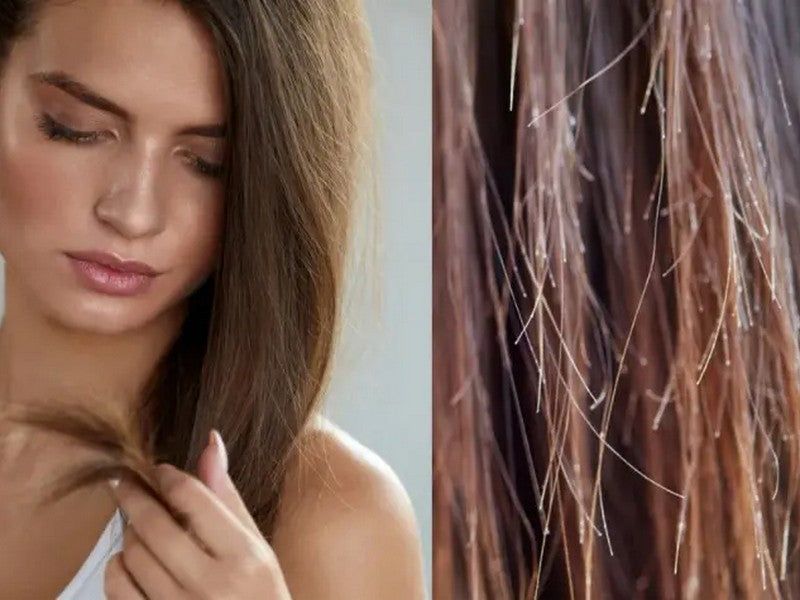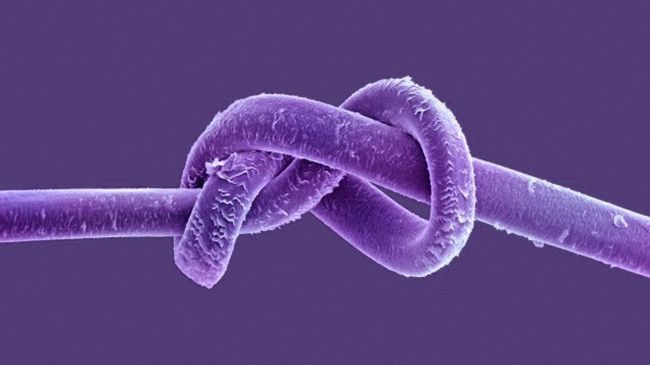Does that sound crazy? This may seem quite offbeat, but yes...your hair can actually fracture!
We are referring to defects in the hair shaft. Hair shaft defects or hair shaft disorders are quite common and indicate an underlying pathology. This is something you cannot diagnose yourself at home. This is a condition that requires professional diagnosis and treatment accordingly.
As we always say, when you know the root of the problem, you can treat it appropriately and control it in the long run. And with conditions like this, the expertise and intervention of a professional is very necessary.
Today we are going to break this topic down into simple terms and help you understand what these hair defects are, what Trichorrhexis Nodosa is and how to treat it.
What is trichorrhexis nodosa?
Hair is an appendage of a layer of skin called the epidermis (the outer layer). It consists of two distinct parts, namely the hair follicle and the hair shaft .The hair follicle is the basic unit of hair production. The hair shaft, simply put, is the strand of hair you see above your scalp . It consists of a cortex , cuticular cells and a medulla. It is made up of a protein called keratin which is compacted and fused. The keratin protein is made up of amino acids linked together by a polypeptide chain called the alpha helix (linked by chemical bonds).
Read our hair anatomy blog to understand the structure and composition of hair .
What are hair shaft defects?
Hair shaft disorders or defects are a fairly diverse group of hair shaft abnormalities that may be congenital or acquired. While some of these disorders cause fragility of the hair shaft, which results in increased hair breakage, others can change the appearance or texture of your hair, without making it as fragile.
On clinical examination, structural changes to the hair shaft may be part of a cluster of symptoms. Changes to the hair shaft over a large portion of the scalp can cause conditions such as alopecia, frizzy and woolly hair, or sometimes go completely unnoticed unless microscopically examined. As mentioned above, this is not a disease that you can diagnose and treat yourself!
Here are some of the known hair shaft disorders, in brief:
- Trichorrhexis nodosa (TN) : Trichorrhexis nodosa or trichorrhexis nodosa is a common abnormality of the hair shaft. It is characterized by the presence of nodules in the hair strand which cause hair breakage and alopecia.
- Trichoclasia : Trichoclasia (“green stick” fracture of the hair shaft) is a transverse fracture, splinted, by an intact cuticle. In this condition, no consistent abnormality of the cuticle or cortex is observed.
- Trichoptilosis : This is the longitudinal splitting of the hair shaft or split ends . Rough brushing or physical and chemical trauma can lead to trichoptilosis . Loss of the cuticle due to bad weather is the cause of this condition. Cortical fibers separate like the frayed ends of a rope, giving rise to split ends or "frizz." Trichoptilosis is a fairly common hairline fracture due to trauma. Today there is a brush that cuts split ends !
- Pseudomonilethrix : In this condition, irregular beads or knots are seen along the hair shaft. The pearly appearance is due to expansion of the normal hair shaft, due to indentation and/or flattening. Pseudomonilethrix can cause hair to become brittle and breakage, causing partial baldness.
- Trichonodosis : “Tangles in the hair” is the common term for this condition, as is the symptom. Observed more often on curly hair, this condition can be either genetic or acquired following trauma. It has no clinical significance.
- Trichoschisis : This term refers to a clear transverse break on the hair shaft. It is due to the absence of cuticle in the area concerned. It is generally observed in congenitally fragile hair with low sulfur content.
- Trichorrhexis Invaginata (Bamboo Hair) : Trichorrhexis Invaginata or Bamboo Hair, as it is commonly known, is a distinctive abnormality of the hair shaft that can occur sporadically, either in normal hair or with other abnormalities of the hair shaft, or regularly as a marker of Netherton syndrome.
- Oblique Fractures – Tapered Fracture : This condition causes a pencil-point appearance. It is due to the inhibition of the synthesis of nucleic acids and proteins leading to mitosis (cell division - simple duplication of a cell and all its parts) during the anagen phase.
- Trichomalacia : Trichomalacia is the deterioration of the hair shaft that occurs on the underlying anagen hair, following epilation or repeated hair pulling. It is most commonly seen in people suffering from trichotillomania .
- Green Hair : This condition is always associated with the presence of copper in the hair in one form or another and tends to affect bleached hair. It can result from overexposure to swimming pool water, where chloride treatments or copper algaecides are used. It can also come from high levels of copper in household water pipes.
- Bubble hair : Bubble hair is when the cross section of the hair shaft has rows of bubbles. It is associated with hair coloring and frequent use of hair dryers. It is said to be caused by focused heating of damp hair. This can produce bubbles in the hair shaft, causing the hair fibers to become dry and brittle.
Today we are going to discuss one of the hair shaft disorders mentioned above that is most commonly encountered in clinical practice – Trichorrhexis Nodosa .
Also discover: what is trichoscopy !
What is trichorrhexis nodosum (TN)?
Also known as hair shaft fracture, Wiki defines trichorrhexia nodosa as a hair shaft defect characterized by thickening or weak spots (knots) that cause the hair to break easily.
The condition basically leads to hair being and looking damaged, lack of hair growth, and ultimately hair loss. It can be inherited/congenital or acquired. The acquired form is the most common. It is most often observed due to alteration due to physical, mechanical or chemical causes. It tends to be distal (far from the root), where the alteration is most significant.
TN is characterized by the formation and presence of nodules along the hair shaft, which leads to a strong tendency to breakage. When the condition spreads over a large area, it leads to alopecia.
Under the microscope, TN shows small cracks on the hair shaft, from which several fibers emerge that look like two brushes pushed against each other in opposite directions. The nodules are whitish yellow in color and are distributed randomly along the hair shaft. They make hair fragile and prone to breakage easily.
As we mentioned, this defect can also be hereditary (although it is most often acquired) and the condition manifests itself during the first year of birth of affected children. It is transmitted in an autosomal dominant manner.
What are the causes of trichorrhexis nodosa (TN)?
Trichorrhexia nodosa is mainly caused by certain underlying disorders, even rare ones, such as (non-exhaustive list),
- Hypothyroidism
- Argininosuccinic aciduria - accumulation of ammonia in the body
- Netherton syndrome
- Menkes syndrome, also known as Menkes frizzy hair syndrome.
- Certain abnormalities such as abnormal development of the skin, hair, nails, teeth, or sweat glands (ectodermal dysplasia).
- Trichothiodystrophy – an inherited disease that causes brittle hair, skin problems and even intellectual disability in some.
- Malnutrition or endocrinopathy, particularly iron deficiency.
- Biotin deficiency - this is an inherited disease, in which the body is unable to use biotin productively.
The other cause, but more common, is the acquired type, where some physical and chemical stress to the hair causes trichorrhexia nodosa.
Some of the physical factors responsible for damaging the hair shaft include the following,
- excessive combing of hair
- hair straightening and perms
- Drying with a hairdryer
- Excessive and frequent brushing
- Aggressive scalp massage
- Permanent backcombing of hair
- Stressful hairstyles where the hair is pulled very tight, stressing the shafts,
- Excessive application of heat for styling - use of high temperatures
- Prolonged/repeated exposure to ultraviolet
- Rolling and hitting your head
- Habitual tics like trichotillomania.
- Scratching and pulling associated with itchy dermatoses, such as seborrheic dermatitis and pediculosis.
Also, chemical trauma like,
- excessive exposure to salt or chlorinated water
- Excessive use of shampoo
- Discoloration
- Frequent application of permanent hair liquid, hair dyes.
- Frequent use of hair sprays
- Using chemical hair straighteners
- Using Selenium Shampoo
...and many others that your trichologist will be able to detail for you.
Trichorrhexis nodosa is ultimately a response to physical or chemical trauma. In most cases, it is this cause - a reflection of the amount of trauma inflicted on the hair shafts. It is in very rare cases that an inherent or structural defect is observed.
What are common symptoms?
The most common symptoms are small whitish-yellow nodules, at irregular intervals, visible along the entire length of the stem. The number of nodules and intervals may vary depending on the length of the hair. Each nodule represents the area of cuticular cell rupture, resulting in fraying and separation of the underlying cortical fibers. This phenomenon is only visible under a microscope!
However, there are some symptoms you can spot. And when this is the case, you must seek immediate professional intervention.
- Patchy hair
- Dull and very brittle hair
- Hair breaks very easily
- Lack of hair growth
- The ends of the hair shaft are very thin and split .
- Whitish discoloration of the tips.
How can a trichologist help you?
When you consult a trichologist, a detailed diagnosis is carried out. The diagnosis of TN is established using microscopic examination. A strand of hair is removed and examined under a microscope to detect the characteristic whitish nodules. Sometimes a skin biopsy is also done to check for genetic mutations.
In recent times, the advanced diagnostic approach employing



